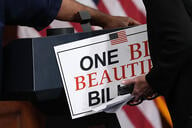You have /5 articles left.
Sign up for a free account or log in.
States’ financial support for higher education grew only slightly between the 2017 and 2018 fiscal years, with more than a third of states decreasing their funding and another dozen increasing it only slightly, according to an annual survey released today.
Across the country, state fiscal support for higher education grew by just 1.6 percent, according to the Grapevine survey, which provides an early look each year at states’ funding for higher education. That was down sharply from a 4.2 percent increase last year and represents the lowest annual growth in the last five years.
National Annual Percent Changes in State Fiscal Support For Higher Education
| Fiscal Year | Change From Previous Year |
|---|---|
| 2014 | 5.9% |
| 2015 | 5% |
| 2016 | 2.4% |
| 2017 | 4.2% |
| 2018 | 1.6% |
“We’ve seen only anemic growth nationwide, with the exception of a few states,” said James Palmer, Grapevine editor and a professor of higher education at Illinois State University. The Grapevine survey is a project of the university’s Center for the Study of Education Policy and the State Higher Education Executive Officers Association.
“This probably suggests the struggle of many states to sustain the revenue needed to increase funding for colleges and universities,” Palmer said of this year’s slow growth in higher ed funding. “In other words, the fiscal capacity to increase funding for colleges and universities doesn’t seem to be there.”
Still, funding conditions vary significantly from state to state. A total of 19 states reported decreases between the 2017 fiscal year, which spans 2016-17, and the 2018 fiscal year, which spans 2017-18. Ohio was home to the smallest of the decreases, 0.1 percent. North Dakota’s was the largest, a drop of 14.6 percent.
Another 12 states increased funding by less than 2 percent, and 18 reported increases of more than 2 percent. Florida showed the largest increase in funding -- the Sunshine State boosted higher ed funding by 11.3 percent.
Meanwhile, funding in one more state, Maine, was essentially flat. Washington, D.C., which is being included in the survey for only the second year, increased funding by 2 percent. Data for Puerto Rico, which was included for the first time last year, was not yet available following the upheaval there caused by Hurricane Maria.
This year’s survey did include data for Illinois, which broke out of a multiyear budget impasse that prevented it from being included in Grapevine tables last year.
Regardless of whether 2018 funding is sufficient for the year, the national picture could cause some concern for those worried about adequate money for public higher education over the long run. The national economy performed well last year, which theoretically should have provided more tax revenue for states and allowed them to spend more. Some of the connection might be lost in individual state budgeting and timing details, but the fact remains that higher ed funding generally rose only incrementally.
And reporting last year from the National Conference of State Legislatures found that for the first time since the Great Recession, a significant number of states were facing budget shortfalls. Most states' budgets were stable, but growth in state revenues was often not keeping pace with demand for government services. Nor have revenues been keeping pace with the rest of the economy.
“It’s really hard, sometimes, to be optimistic about increased funding for higher education when we juxtapose the anemic growth this year against the background of what seems to be an otherwise OK economy,” Palmer said.
Many states seem to be stuck between competing priorities. On one hand, the free tuition movement has grown from two-year colleges to include a free four-year program in New York State. On the other hand, states generally do not seem to be inclined to raise taxes to pay for free tuition.
“Much will depend on the political will,” Palmer said. “How do you balance those competing priorities?”
Amid that discussion, it should be pointed out that New York’s support for higher education only grew by 1.9 percent between 2017 and 2018, to $5.9 billion. The fall semester was the first for the state’s Excelsior Scholarship, a free-tuition program for full-time students from families earning less than certain income thresholds. The scholarship is being implemented over several years with income limits increasing, but nonetheless it has gone to tens of thousands of students.
When pushing to enact the scholarship program last year, Governor Andrew Cuomo’s office budgeted a cost of $87 million in its first year because New York already has other generous grant programs for students. The estimate seemed low to some, meaning the state’s spending on higher ed will be closely watched.
Cuomo has already drawn fire from education advocates over funding for public universities, both at the end of last year and after he unveiled a new budget proposal this year.
The Down States
Of course, New York did increase funding in 2018 -- something not every state can say. Officials in North Dakota attributed the fact that the state had the largest year-over-year higher ed funding drop in the country to a state budget hurt by the energy and agricultural sectors.
“The largest economic drivers in our state are agriculture and energy, which includes oil and coal,” said Tammy Dolan, vice chancellor of administrative affairs at the North Dakota University System. “As the last few years have not been kind to those industries, they have had an impact on the amount of state funds that are available.”
North Dakota has a biennial budget, so officials know state funding will not increase next year. They’ve put in place several strategies to deal with the decreased funding, including task forces to find efficiencies at the system and institutional levels. Since 2016, about 500 full-time staff positions have been cut across 11 institutions, Dolan said. The university system has a total of about 7,000 full-time employees.
Examining several years of data for North Dakota shows the state's higher ed funding dropping back down after a brief increase. The state's higher ed funding totaled $358.5 million in 2018 after coming in at $419.7 million in 2017 and $405.7 million in 2016. Funding is now closer to its 2013 level, which was $343.8 million.
Nationally, comparing the latest state funding picture to one from two years prior shows some long-term gains in state funding. State appropriations to higher education across the country grew by 5.9 percent between the 2016 and 2018 fiscal years. The growth is skewed upward because of an extreme 30.2 percent two-year increase reported by Illinois, which rebounded from its institutions receiving a diminished amount of stopgap funding during the state budget standoff.
A total of 34 states besides Illinois show two-year gains in funding, with Arkansas recording the lowest increase, 0.1 percent, and Hawaii reporting the highest, 18.7 percent. The other 15 states decreased support for higher ed between 2016 and 2018 by amounts ranging from a slip of 0.1 percent in New Jersey to a drop of 13.3 percent in Mississippi.
Comparing the 2018 data to figures from five years in the past reveals that, nationally, state support for higher education has risen by 20.7 percent. A total of 40 states had five-year increases since 2013. The smallest increase, 1.1 percent, was in Arizona. The largest, 52.5 percent, was in California.
The other 10 states dropped funding for higher ed over the five-year span. Of that group, New Mexico had the smallest decline, 0.5 percent. West Virginia had the biggest plunge -- 20.6 percent.
Grapevine data cover tax and nontax state support for college and university operations. They also include support for other higher ed activities. States are asked for information on their funding for four-year institutions, community colleges and vocational-technical colleges, as well as appropriations to coordinating and governing boards, appropriations to state student financial aid, funding bound for higher ed but appropriated to other state agencies, and appropriations for private higher ed institutions. They are asked not to include appropriations for capital costs, debt service, money drawn from most federal sources, funds drawn from student fees and auxiliary enterprises.
Grapevine warns that the data are an early, tentative look at higher ed funding and that some estimates are subject to change. The data are broad -- figures don’t indicate any single institution’s funding.
Nor does the survey account for changes in the number of students enrolling, which can vary significantly from state to state and institution to institution. That means per-student analyses aren't possible -- an important point since declining funding can mean a very different thing in a state where overall enrollment is falling than it does in a state where enrollment is rising. Nationally, college enrollment has been declining for six straight years, although four-year public institutions have fared much better than other types of institution. Community colleges and especially for-profit institutions have seen the most significant loss of students.
The report typically comes a few months before a more comprehensive State Higher Education Finance report issued by the State Higher Education Executive Officers Association.
Percent Change in State Appropriations by State
| State | Total Support, 2017-18 (dollars) | 1-Year Change | 5-Year Change |
|---|---|---|---|
| Alabama | 1,618,261,945 | 3.9% | 15.0% |
| Alaska | 327,222,500 | -2.5% | -12.2% |
| Arizona | 852,217,100 | 1.3% | 1.1% |
| Arkansas | 990,308,071 | 1.2% | -2.4% |
| California | 14,300,823,000 | 3.8% | 52.5% |
| Colorado | 887,037,491 | 2.3% | 39.0% |
| Connecticut | 1,143,736,037 | -1.0% | 28.9% |
| Delaware | 237,069,500 | 1.0% | 9.5% |
| Florida | 5,051,738,013 | 11.3% | 51.3% |
| Georgia | 3,423,355,485 | 6.6% | 30.4% |
| Hawaii | 716,718,368 | 7.4% | 36.2% |
| Idaho | 478,997,900 | 4.1% | 33.0% |
| Illinois | 4,349,491,603 | -5.5% | 1.3% |
| Indiana | 1,773,727,687 | 1.6% | 13.9% |
| Iowa | 816,055,053 | -1.6% | 3.6% |
| Kansas | 764,547,532 | -0.6% | -3.9% |
| Kentucky | 1,173,159,100 | 0.2% | -1.2% |
| Louisiana | 1,156,078,487 | 6.7% | -1.5% |
| Maine | 301,805,964 | 0.0% | 13.5% |
| Maryland | 1,992,867,551 | 0.6% | 23.2% |
| Massachusetts | 1,564,337,918 | 1.3% | 24.6% |
| Michigan | 1,917,024,500 | 2.1% | 19.2% |
| Minnesota | 1,653,249,000 | 7.1% | 28.6% |
| Mississippi | 900,155,014 | -11.2% | -2.7% |
| Missouri | 988,536,584 | -2.3% | 6.2% |
| Montana | 243,920,115 | -3.3% | 20.6% |
| Nebraska | 760,198,501 | 0.9% | 15.3% |
| Nevada | 622,021,005 | 8.9% | 31.7% |
| New Hampshire | 127,935,617 | 2.2% | 49.4% |
| New Jersey | 2,065,933,000 | -0.8% | 9.4% |
| New Mexico | 828,197,600 | -3.1% | -0.5% |
| New York | 5,860,223,303 | 1.9% | 14.6% |
| North Carolina | 4,020,836,353 | 1.2% | 7.2% |
| North Dakota | 358,491,256 | -14.6% | 4.3% |
| Ohio | 2,300,904,761 | -0.1% | 12.2% |
| Oklahoma | 829,597,660 | -3.9% | -20.6% |
| Oregon | 859,469,660 | 5.5% | 48.0% |
| Pennsylvania | 1,651,732,000 | -2.4% | 1.2% |
| Rhode Island | 198,291,070 | 5.7% | 21.1% |
| South Carolina | 1,097,979,545 | 0.3% | 20.6% |
| South Dakota | 233,805,655 | -2.0% | 19.1% |
| Tennessee | 1,844,857,699 | 6.5% | 26.8% |
| Texas | 7,493,114,733 | -1.6% | 18.0% |
| Utah | 1,025,936,100 | 4.8% | 37.0% |
| Vermont | 94,462,556 | 2.3% | 5.7% |
| Virginia | 2,013,572,522 | -1.9% | 17.6% |
| Washington | 1,906,810,000 | 1.5% | 35.5% |
| West Virginia | 470,910,031 | -2.7% | -14.5% |
| Wisconsin | 1,509,157,200 | 2.4% | 29.7% |
| Wyoming | 373,759,707 | -2.2% | -2.5% |
| Washington, D.C. | 78,180,000 | 2.0% | 3.7% |




